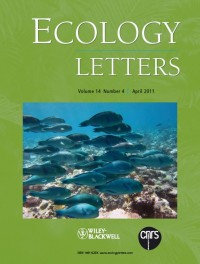
ISSN: 1461-023X
Journal Home
Journal Guideline
Ecology Letters Q1 Unclaimed
Ecology Letters is a journal indexed in SJR in Ecology, Evolution, Behavior and Systematics with an H index of 330. It has a price of 2917 €. It has an SJR impact factor of 3,905 and it has a best quartile of Q1. It is published in English. It has an SJR impact factor of 3,905.
Ecology Letters focuses its scope in these topics and keywords: species, distribution, productivity, climate, diversity, ecosystem, elevated, evolutionary, framework, functional, ...
Type: Journal
Type of Copyright:
Languages: English
Open Access Policy: Open Choice
Type of publications:
Publication frecuency: -
2917 €
Inmediate OANPD
Embargoed OA0 €
Non OAMetrics
3,905
SJR Impact factor330
H Index228
Total Docs (Last Year)637
Total Docs (3 years)16740
Total Refs5471
Total Cites (3 years)349
Citable Docs (3 years)8.4
Cites/Doc (2 years)73.42
Ref/DocOther journals with similar parameters
Fungal Diversity Q1
Genome Biology Q1
Annual Review of Ecology, Evolution, and Systematics Q1
Trends in Ecology and Evolution Q1
Annual Review of Entomology Q1
Compare this journals
Aims and Scope
Best articles by citations
Quantifying biodiversity: procedures and pitfalls in the measurement and comparison of species richness
Predicting species distribution: offering more than simple habitat models
The metacommunity concept: a framework for multi-scale community ecology
Global analysis of nitrogen and phosphorus limitation of primary producers in freshwater, marine and terrestrial ecosystems
The unseen majority: soil microbes as drivers of plant diversity and productivity in terrestrial ecosystems
Impacts of climate change on the future of biodiversity
Towards a worldwide wood economics spectrum
Ecological impacts of invasive alien plants: a meta-analysis of their effects on species, communities and ecosystems
Quantifying the evidence for biodiversity effects on ecosystem functioning and services
The impacts of climate change in coastal marine systems
Global change and species interactions in terrestrial ecosystems
Plant species traits are the predominant control on litter decomposition rates within biomes worldwide
Multivariate dispersion as a measure of beta diversity
The merging of community ecology and phylogenetic biology
Conserving biodiversity under climate change: the rear edge matters
Functional diversity: back to basics and looking forward
Mechanistic niche modelling: combining physiological and spatial data to predict species’ ranges
Understanding relationships among multiple ecosystem services
Interactive and cumulative effects of multiple human stressors in marine systems
A new statistical approach for assessing similarity of species composition with incidence and abundance data
Stoichiometry of soil enzyme activity at global scale
"Viability in a pink environment: why ""white noise"" models can be dangerous"
View more

Comments